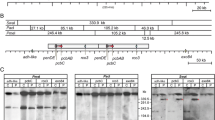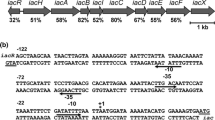Abstract
The transcription factor CreA is the main regulator responsible for carbon repression in filamentous fungi. CreA is a wide domain regulator that binds to regulatory elements in the promoters of target genes to repress their transcription. Penicillin biosynthesis and the expression of penicillin biosynthetic genes are subject to carbon repression. However, evidence of the participation of CreA in this regulation is still lacking, and previous studies on the promoter of the pcbC gene of Aspergillus nidulans indicated the lack of involvement of CreA in its regulation. Here we present clear evidence of the participation of CreA in carbon repression of penicillin biosynthesis and expression of the pcbAB gene, encoding the first enzyme of the pathway, in Penicillium chrysogenum. Mutations in cis of some of the putative CreA binding sites present in the pcbAB gene promoter fused to a reporter gene caused an important increase in the measured enzyme activity in glucose-containing medium, whereas activity in the medium with lactose was not affected. An RNAi strategy was used to attenuate the expression of the creA gene. Transformants expressing a small interfering RNA for creA showed higher penicillin production, and this increase was more evident when glucose was used as carbon source. These results confirm that CreA plays an important role in the regulation of penicillin biosynthesis in P. chrysogenum and opens the possibility of its utilization to improve the industrial production of this antibiotic.





Similar content being viewed by others
References
Brakhage AA, Browne P, Turner G (1992) Regulation of Aspergillus nidulans penicillin biosynthesis and penicillin biosynthesis genes acvA and ipnA by glucose. J Bacteriol 174:3789–3799
Cantoral JM, Díez B, Barredo JL, Álvarez E, Martín JF (1987) High frequency transformation of Penicillium chrysogenum. Bio/Technology 5:494–497. doi:10.1038/nbt0587-494
Cantoral JM, Gutiérrez S, Fierro F, Gil-Espinosa S, van Liempt H, Martín JF (1993) Biochemical characterization and molecular genetics of nine mutants of Penicillium chrysogenum impaired in penicillin biosynthesis. J Biol Chem 268:737–744
Casqueiro J, Gutiérrez S, Bañuelos O, Hijarrubia MJ, Martín JF (1999) Gene targeting in Penicillium chrysogenum: disruption of the lys2 gene leads to penicillin overproduction. J Bacteriol 181:1181–1188
Chu Y-W, Renno D, Saunders G (1997) Extracellular pH affects regulation of the pcbAB gene in Penicillium chrysogenum. Appl Microbiol Biotechnol 47:250–254. doi:10.1007/s002530050922
Cubero B, Scazzochio C (1994) Two different, adjacent and divergent zinc finger binding sites are necessary for CREA-mediated carbon catabolite repression in the proline gene cluster of Aspergillus nidulans. EMBO J 13:407–415
de la Serna I, Ng D, Tyler BM (1999) Carbon regulation of ribosomal genes in Neurospora crassa occurs by a mechanism which does not require Cre-1, the homologue of the Aspergillus carbon catabolite repressor, CreA. Fungal Genet Biol 26:253–269. doi:10.1006/fgbi.1999.1121
Díez B, Álvarez E, Cantoral JM, Barredo JL, Martín JF (1987) Selection and characterization of pyrG mutants of Penicillium chrysogenum lacking orotidine-5-phosphate decarboxylase and complementation by the pyr4 gene of Neurospora crassa. Curr Genet 12:277–282. doi:10.1007/BF00435290
Díez B, Gutiérrez S, Barredo JL, van Solingen P, van deer Voort LHM, Martín JF (1990) The cluster of penicillin biosynthetic genes. J Biol Chem 265:16358–16365
Dowzer CEA, Kelly JM (1991) Analysis of the creA gene, a regulator of carbon catabolite repression in Aspergillus nidulans. Mol Cell Biol 11:5701–5709. doi:10.1128/MCB.11.11.5701
Espeso EA, Peñalva MA (1992) Carbon catabolite repression can account for the temporal pattern of expression of a penicillin biosynthetic gene in Aspergillus nidulans. Mol Microbiol 6:1457–1465. doi:10.1111/j.1365-2958.1992.tb00866.x
Espeso EA, Peñalva MA (1994) In vitro binding of the two-finger repressor CreA to several consensus and non-consensus sites at the ipnA upstream region is context dependent. FEBS Lett 342:43–48. doi:10.1016/0014-5793(94)80581-4
Espeso EA, Tilburn J, Arst HN Jr, Peñalva MA (1993) pH regulation is a major determinant in expression of a fungal penicillin biosynthetic gene. EMBO J 12:3947–3956
Fierro F, Montenegro E, Gutiérrez S, Martín JF (1996a) Mutants blocked in penicillin biosynthesis show a deletion of the entire penicillin gene cluster at a specific site within a conserved hexanucleotide sequence. Appl Microbiol Biotechnol 44:597–604. doi:10.1007/BF00172491
Fierro F, Kosalkova K, Gutiérrez S, Martín JF (1996b) Autonomously replicating plasmids carrying the AMA1 region in Penicillium chrysogenum. Curr Genet 29:482–489. doi:10.1007/BF02221518
García-Rico RO, Martín JF, Fierro F (2007) The pga1 gene of Penicillium chrysogenum encodes a heterotrimeric G protein alpha subunit that controls growth and development. Res Microbiol 158:437–446. doi:10.1016/j.resmic.2007.03.001
García-Rico RO, Fierro F, Martín JF (2008) Heterotrimeric Gα protein Pga1 of Penicillium chrysogenum controls conidiation mainly by a cAMP-independent mechanism. Biochem Cell Biol 86:57–69. doi:10.1139/O07-148
Gutiérrez S, Marcos AT, Casqueiro J, Kosalkova K, Fernández FJ, Velasco J, Martín JF (1999) Transcription of the pcbAB, pcbC and penDE genes of Penicillium chrysogenum AS-P-78 is repressed by glucose and the repression is not reversed by alkaline pHs. Microbiology 145:317–324. doi:10.1099/13500872-145-2-317
Janus D, Hoff B, Kück U (2009) Evidence for Dicer-dependent RNA interference in the industrial penicillin producer Penicillium chrysogenum. Microbiology 155:3946–3956. doi:10.1099/mic.0.032763-0
Jekosch K, Kück U (2000) Loss of glucose repression in an Acremonium chrysogenum beta-lactam producer strain and its restoration by multiple copies of the cre1 gene. Appl Microbiol Biotechnol 54:556–563. doi:10.1007/s002530000422
Jonkers W, Rep M (2009) Mutation of CRE1 in Fusarium oxysporum reverts the pathogenicity defects of the FRP1 deletion mutant. Mol Microbiol 74:1100–1113. doi:10.1111/j.1365-2958.2009.06922.x
Klein CJL, Olsson L, Nielsen J (1998) Glucose control in Saccharomyces cerevisiae: the role of MIG1 in metabolic functions. Microbiology 144:13–24. doi:10.1099/00221287-144-1-13
Kulmburg P, Mathieu M, Dowzer C, Kelly J, Felenbok B (1993) Specific binding sites in the alcR and alcA promoters of the ethanol regulon for the CreA repressor mediating carbon catabolite repression in Aspergillus nidulans. Mol Microbiol 7:847–857. doi:10.1111/j.1365-2958.1993.tb01175.x
MacCabe AP, Riach MBR, Unkles SE, Kinghorn JR (1990) The Aspergillus nidulans npeA locus consists of three contiguous genes required for penicillin biosynthesis. EMBO J 9:279–287
Martin JF (2000) Molecular control of expression of penicillin biosynthesis genes in fungi: regulatory proteins interact with a bidirectional promoter region. J Bacteriol 182:2355–2362. doi:10.1128/JB.182.9.2355-2362.2000
Miller JH (1972) Assay of β-galactosidase. In Miller JH (ed) Experiments in molecular genetics: a laboratory manual, 2nd edn. Cold Spring Harbor Laboratory, Cold Spring Harbor, New York, pp 352–355
Mogensen J, Nielsen HB, Hofmann G, Nielsen J (2006) Transcription analysis using high-density micro-arrays of Aspergillus nidulans wild-type and creA mutant during growth on glucose or ethanol. Fungal Genet Biol 43:593–603. doi:10.1016/j.fgb.2006.03.003
Nakari-Setälä T, Paloheimo M, Kallio J, Vehmaanperä J, Penttilä M, Saloheimo M (2009) Genetic modification of carbon catabolite repression in Trichoderma reesei for improved protein production. Appl Environ Microbiol 75:4853–4860. doi:10.1128/AEM.00282-09
Naranjo L, Martín de Valmaseda E, Casqueiro J, Ullán RV, Lamas-Maceiras M, Bañuelos O, Martín JF (2004) Inactivation of the lys7 gene, encoding saccharopine reductase in Penicillium chrysogenum, leads to accumulation of the secondary metabolite precursors piperideine-6-carboxylic acid and pipecolic acid from α-aminoadipic acid. Appl Environ Microbiol 70:1031–1039. doi:10.1128/AEM.70.2.1031-1039.2004
Nehlin JO, Ronne H (1990) Yeast MIG1 repressor is related to the mammalian early growth response and Wilms’ tumour finger proteins. EMBO J 9:2891–2898
Pérez-Esteban B, Orejas M, Gómez-Pardo E, Peñalva MA (1993) Molecular characterization of a fungal secondary metabolism promoter: transcription of the Aspergillus nidulans isopenicillin N synthetase gene is modulated by upstream negative elements. Mol Microbiol 9:881–895. doi:10.1111/j.1365-2958.1993.tb01746.x
Portnoy T, Margeot A, Linke R, Atanasova L, Fekete E, Sándor E, Hartl L, Karaffa L, Druzhinina IS, Seiboth B, Le Crom S, Kubicek CP (2011) The CRE1 carbon catabolite repressor of the fungus Trichoderma reesei: a master regulator of carbon assimilation. BMC Genomics 12:269. doi:10.1186/1471-2164-12-269
Revilla G, López-Nieto MJ, Luengo JM, Martín JF (1984) Carbon catabolite repression of penicillin biosynthesis by Penicillium chrysogenum. J Antibiot 37:781–789. doi:10.7164/antibiotics.37.781
Revilla G, Ramos FR, López-Nieto MJ, Álvarez E, Martín JF (1986) Glucose represses formation of δ-(L-α-aminoadipyl)-L-cysteinyl-D-valine and isopenicillin N synthase but not penicillin acyltransferase in Penicillium chrysogenum. J Bacteriol 168:947–952
Ronne H (1995) Glucose repression in fungi. Trends Genet 11:12–17. doi:10.1016/S0168-9525(00)88980-5
Sambrook J, Fritsch EF, Maniatis T (1989) Molecular cloning. A laboratory manual. Cold Spring Harbor Laboratory Press, Cold Spring Harbor, New York
Sánchez S, Chávez A, Forero A, García-Huante Y, Romero A, Sánchez M, Rocha D, Sánchez B, Avalos M, Guzmán-Trampe S, Rodríguez-Sanoja R, Langley E, Ruiz B (2010) Carbon source regulation of antibiotic production. J Antibiot 63:442–459. doi:10.1038/ja.2010.78
Shroff RA, O’Connor SM, Hynes MJ, Lockington RA, Kelly JM (1997) Null alleles of creA, the regulator of carbon catabolite repression in Aspergillus nidulans. Fungal Genet Biol 22:28–38. doi:10.1006/fgbi.1997.0989
Sophianopoulou V, Suárez T, Diallinas G, Scazzochio C (1993) Operator derepressed mutations in the proline utilization gene cluster of Aspergillus nidulans. Mol Gen Genet 236:209–213. doi:10.1007/BF00277114
Strauss J, Mach RL, Zeilinger S, Stöffler G, Wolschek M, Hartler G, Kubicek CP (1995) Cre1 the carbon catabolite repressor protein from Trichoderma reesei. FEBS Lett 376:103–107. doi:10.1016/0014-5793(95)01255-5
Suárez T, Peñalva MA (1996) Characterization of a Penicillium chrysogenum gene encoding a PacC transcription factor and its binding sites in the divergent pcbAB-pcbC promoter of the penicillin biosynthetic cluster. Mol Microbiol 20:529–540. doi:10.1046/j.1365-2958.1996.5421065.x
Tudzynski B, Liu S, Kelly JM (2000) Carbon catabolite repression in plant pathogenic fungi: isolation and characterization of the Gibberella fujikuroi and Botrytis cinerea cre1 genes. FEMS Microbiol Lett 184:9–15. doi:10.1016/S0378-1097(00)00012-4
Ullán RV, Godio RP, Teijeira F, Vaca I, García-Estrada C, Feltrer R, Kosalkova K, Martín JF (2008) RNA-silencing in Penicillium chrysogenum and Acremonium chrysogenum: validation studies using β-lactam genes expression. J Microbiol Meth 75:209–218. doi:10.1016/j.mimet.2008.06.001
van den Berg MA (2011) Impact of the Penicillium chrysogenum genome on industrial production of metabolites. Appl Microbiol Biotechnol 92:45–53. doi:10.1007/s00253-011-3476-z
van den Berg MA, Albang R, Albermann K, Badger JH, Daran JM, Driessen AJ, Garcia-Estrada C, Fedorova ND, Harris DM, Heijne WH, Joardar V, Kiel JA, Kovalchuk A, Martín JF, Nierman WC, Nijland JG, Pronk JT, Roubos JA, van der Klei IJ, van Peij NN, Veenhuis M, von Döhren H, Wagner C, Wortman J, Bovenberg RA (2008) Genome sequencing and analysis of the filamentous fungus Penicillium chrysogenum. Nat Biotechnol 26:1161–1168. doi:10.1038/nbt.1498
Ziv C, Gorovits R, Yarden O (2008) Carbon source affects PKA-dependent polarity of Neurospora crassa in a CRE-1-dependent and independent manner. Fungal Genet Biol 45:103–116. doi:10.1016/j.fgb.2007.05.005
Acknowledgments
This work was supported by a Grant of the European Union (EUROFUNGBASE, LSSG-CT-2005-018964). C. Cepeda-García received a PhD fellowship associated to a research project from the Ministry of Science and Technology of Spain (BIO2000-1726-C02-01). R. Domínguez-Santos was granted a fellowship from the Junta de Castilla y León (ORDEN EDU/1204/2010) cofinanced by the European Social Fund.
Conflict of interest
The authors declare that they have no conflict of interest.
Author information
Authors and Affiliations
Corresponding author
Additional information
Cristina Cepeda-García, Rebeca Domínguez-Santos and Ramón O. García-Rico contributed equally to this work.
Electronic supplementary material
Below is the link to the electronic supplementary material.
ESM 1
(PDF 926 kb)
Rights and permissions
About this article
Cite this article
Cepeda-García, C., Domínguez-Santos, R., García-Rico, R.O. et al. Direct involvement of the CreA transcription factor in penicillin biosynthesis and expression of the pcbAB gene in Penicillium chrysogenum . Appl Microbiol Biotechnol 98, 7113–7124 (2014). https://doi.org/10.1007/s00253-014-5760-1
Received:
Revised:
Accepted:
Published:
Issue Date:
DOI: https://doi.org/10.1007/s00253-014-5760-1




